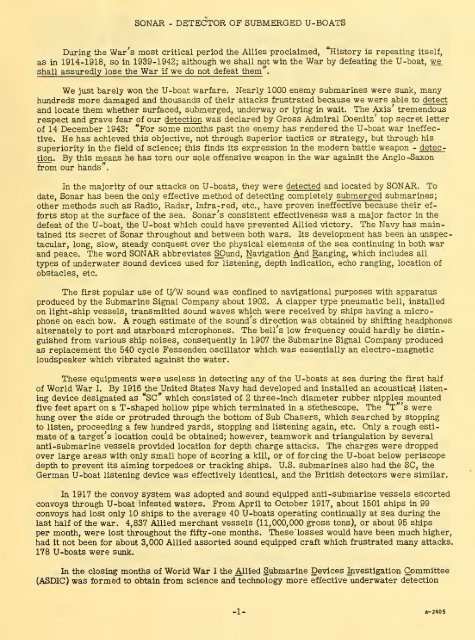Sonar : detector of submerged submarines
Sonar : detector of submerged submarines
Sonar : detector of submerged submarines
You also want an ePaper? Increase the reach of your titles
YUMPU automatically turns print PDFs into web optimized ePapers that Google loves.
SONAR - DETECTOR OF SUBMERGED U-BOATS<br />
During the War's most critical period the Allies proclaimed, "History is repeating itself,<br />
as in 1914-1918, so in 1939-1942; although we shall not win the War by defeating the U-boat, we<br />
shall assuredly lose the War if we do not defeat them ".<br />
We just barely won the U-boat warfare. Nearly 1000 enemy <strong>submarines</strong> were sunk, many<br />
hundreds more damaged and thousands <strong>of</strong> their attacks frustrated because we were able to detect<br />
and locate them whether surfaced, <strong>submerged</strong>, underway or lying in wait. The Axis' tremendous<br />
respect and grave fear <strong>of</strong> our detection was declared by Gross Admiral Doenitz top secret letter<br />
<strong>of</strong> 14 December 1943: "For some months past the enemy has rendered the U-boat war ineffective.<br />
He has achieved this objective, not through superior tactics or strategy, but through his<br />
superiority in the field <strong>of</strong> science; this finds its expression in the modern battle weapon - detection<br />
. By this means he has torn our sole <strong>of</strong>fensive weapon in the war against the Anglo-Saxon<br />
from our hands .<br />
In the majority <strong>of</strong> our attacks on U-boats, they were detected and located by SONAR. To<br />
date. <strong>Sonar</strong> has been the only effective method <strong>of</strong> detecting completely <strong>submerged</strong> <strong>submarines</strong>;<br />
other methods such as Radio, Radar, Infra-red, etc., have proven ineffective because their efforts<br />
stop at the surface <strong>of</strong> the sea. <strong>Sonar</strong>'s consistent effectiveness was a major factor in the<br />
defeat <strong>of</strong> the U-boat, the U-boat which could have prevented Allied victory. The Navy has maintained<br />
its secret <strong>of</strong> <strong>Sonar</strong> throughout and between both wars. Its development has been an unspectacular,<br />
long, slow, steady conquest over the physical elements <strong>of</strong> the sea continuing in both war<br />
and peace. The word SONAR abbreviates SOund, Navigation And Ranging, which includes all<br />
types <strong>of</strong> imderwater sound devices used for listening, depth indication, echo ranging, location <strong>of</strong><br />
obstacles, etc.<br />
The first popular use <strong>of</strong> U/W sound was confined to navigational purposes with apparatus<br />
produced by the Submarine Signal Company about 1902. A clapper type pneumatic bell, installed<br />
on light-ship vessels, transmitted sound waves which were received by ships having a microphone<br />
on each bow. A rough estimate <strong>of</strong> the sound's direction was obtained by shifting headphones<br />
alternately to port and starboard microphones. The bell s low frequency could hardly be distinguished<br />
from various ship noises, consequently in 1907 the Submarine Signal Company produced<br />
as replacement the 540 cycle Fessenden oscillator which was essentially an electro -magnetic<br />
loudspeaker which vibrated against the water.<br />
These equipments were useless in detecting any <strong>of</strong> the U-boats at sea during the first half<br />
<strong>of</strong> World War I. By 1916 the United States Navy had developed and installed an acousticai listening<br />
device designated as "SC" which consisted <strong>of</strong> 2 three-inch diameter rubber nipples mounted<br />
five feet apart on a T-shaped hollow pipe which terminated in a stethescope. The t"'s were<br />
hung over the side or protruded through the bottom <strong>of</strong> Sub Chasers, which searched by stopping<br />
to listen, proceeding a few hundred yards, stopping and listening again, etc. Only a rough estimate<br />
<strong>of</strong> a target's location could be obtained; however, teamwork and triangulation by several<br />
anti-submarine vessels provided location for depth charge attacks. The charges were dropped<br />
over large areas with only small hope <strong>of</strong> scoring a kill, or <strong>of</strong> forcing the U-boat below periscope<br />
depth to prevent its aiming torpedoes or tracking ships. U.S. <strong>submarines</strong> also had the SC, the<br />
German U-boat listening device was effectively identical, and the British <strong>detector</strong>s were similar.<br />
In 1917 the convoy system was adopted and sound equipped anti-submarine vessels escorted<br />
convoys through U-boat infested waters. From April to October 1917, about 1501 ships in 99<br />
convoys had lost only 10 ships to the average 40 U-boats operating continually at sea during the<br />
last half <strong>of</strong> the war. 4,837 Allied merchant vessels (11,000,000 gross tons), or about 95 ships<br />
per month, were lost throughout the fifty-one months. These losses would have been much higher,<br />
had it not been for about 3,000 Allied assorted sound equipped craft which frustrated many attacks.<br />
178 U-boats were sunk.<br />
In the closing months <strong>of</strong> World War I the Allied Submarine Devices Investigation Committee<br />
(ASDIC) was formed to obtain from science and technology more effective underwater detection<br />
-1- *-2»05

















